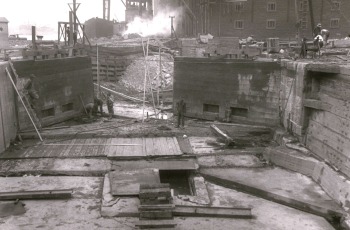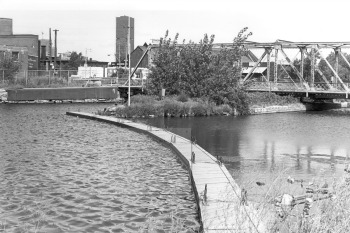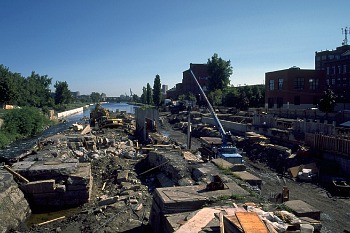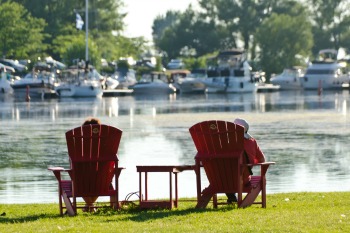
Ceremony on the occasion of the reopening of the Lachine Canal to navigation
20 years of recreational navigation on the Lachine Canal: a retrospective on a colossal project
Lachine Canal National Historic Site
May 17, 2002. Federal and provincial ministers, Secretaries of State, mayors and other dignitaries gathered at Lock No. 5 in Lachine to take part in the inauguration ceremony of the opening of the Lachine Canal to recreational boating. An imposing crowd participated in the colorful popular festival organized on this occasion, and the children took advantage of it to admire the first boats floating in the lock. That was 20 years ago…
Since then, many of you have been weighing anchor at this historic canal to enjoy the beauty of its scenery, the warm sunshine of the summer and the exciting programming that animates this exceptional site in the heart of Montreal. What about going back in time to celebrate a very special anniversary? Full ahead!
Luc-André Mercier, Director of Voies navigables du Québec from 2011 until 2017
Transcript
The Parks Canada logo
Image of the Lachine Canal
Cyclist and people sitting and looking at the canal
Arrival of Luc-André Mercier, director of Quebec Waterways at Parks Canada
My name Is Luc-André Mercier. I am Director of Quebec Waterways.
I have worked at Parks Canada for 32 years.
The Lachine Canal has played two major roles since it opened in 1825. Commercially, it linked the Atlantic Ocean to the Great Lakes region.
Secondly, a key point was the development of water power.
Because of the water power, there were factories and there were employees, so a large share of urban development took place right here.
Archives of the canal. Car crossing a bridge. Image of the canal filled with water.
Journalist (archives, CBC): “The Lachine Canal has been here for so long it was almost taken for granted, but it appears that it won’t be here forever”.
The Lachine Canal couldn’t be expanded. It was simpler to take a path that was completely modern and contemporary at the time, so it was decided to build the St. Lawrence Seaway.
archives (1950) of the canal.
Archive image in the 80's. People on bike watch the empty canal.
It would be eight years before governments stepped in, not to reopen the Lachine Canal, but to develop the urban park.
Images of the restoraton plan for the reopening of the canal
Announcement of the reopening to pleasure boating (Mayor of Montreal, Pierre Bourque, 1997)
The City of Montreal and the Government of Canada invested more than $80 million to redevelop the banks of this exceptional water body and reopen it to pleasure boating in 2002!
construction images
The canal had been completely abandoned. (images of trickling water )
Work was done on the locks, weirs and walls to make sure that the Lachine Canal could be made operational.
Images du canal en reconstruction
May 17, 2002: the canal reopened to pleasure boating
Photos of the reopening of the canal. Politicians, children, celebrations surrounding this day.
Recent images of the Lachine Canal
There was a moment of silence when we realized that something extraordinary had just happened, along with a feeling of relief.
People biking. A lady drinks a coffee in a red chair. Cars and cyclists crossing a bridge.
15 years later…If we just look at the financial side, it has been great. But if we look at it in terms of living environment, integration in the communities, recreational and tourist space, an extraordinary path has been travelled from 2002 to today
People enjoying the sun near the canal
Redpath building
Cyclist
Water flowing in the canal
A message from the gouvernement of Canada
Logo Canada
A bit of history

At a time when navigation was the most efficient means of transporting goods and people, Montreal represented, until the beginning of the 19th century, a breaking point in the navigation towards the interior of the continent. The construction of the Lachine Canal, begun in 1821, would be at the heart of the industrial development of the region. As a matter of fact, this waterway would allow ships to ignore previously impassable rapids and to head for the Great Lakes. It would simultaneously attract many companies that would use its water for energy purposes or for the needs of their manufacturing processes.
In rural areas in the mid-1850s, the banks of the canal thus metamorphosed little by little into an urban fringe. The canal was no longer just a place where one worked: it became a real living environment.
Closed for over 30 years

A major project

The Lachine Canal experienced a revival phase. Literally. A major revitalization project was publicly announced in the spring of 1997, during a press conference given by key stakeholders. The various levels of government spent close to $100 million on the project. These public funds generated private investments of some $250 million. During the construction period, 720 jobs were created by the federal government’s investments alone. Phase 1 of the work under Parks Canada spanned the period from 1997 to 2004, and was aimed at showcasing the commemorative and recreational potential of the Lachine Canal. The urbanistic interventions and the work undertaken by the City of Montréal between 1997 and 2002 concerned the surrounding areas and neighborhoods of the canal.
The most spectacular work was aimed at the rehabilitation and operation of the waterway in order to reopen the canal to small boating for 2002: kilometers of walls to be consolidated, three locks and their weir to be restarted, while respecting the historical structures dating from the last period of use of the canal. Bridges were also raised and new walkways were installed, excavation and rehabilitation of the Peel Basin walls and burying of electrical transmission lines under the newly excavated basins were also carried out.
Finally, a Visitor Services Centre was built in Lachine and service centres were constructed at the other locks. From the design of these great works to their achievement, architects and engineers had been working since the first days of the project. Their accomplishments are certainly the most visible manifestations of the desire to revitalize the national historic site.
It is easy to imagine how the revitalization of the Lachine Canal National Historic Site could be a major challenge. The program included the following: protecting and enhancing hundreds of cultural resources that illustrate more than 300 years of history, bringing back navigation on a divided canal into the heart of an urban area, completing the development of a park and of a trail among the busiest in the region, aligning all of these interventions to a vast program of urban renewal and renovation that affects the entire southwestern part of the island of Montreal. Within Parks Canada, several teams worked to make this ambitious undertaking a success. And it was indeed a success!
Beneficial impacts of a canal there to stay

From its opening in 1825, the Lachine Canal contributed greatly to the urbanization of Montreal and the development of the southwestern part of the city. For more than 100 years, the neighborhoods along this waterway will have experienced the most important industrial activity in the country. Reopening the Lachine Canal to recreational boating will have enabled to achieve one of the most important urban redevelopment projects that the metropolis has known.
In addition to revitalizing the Southwest, to creating a major tourist attraction, to encouraging new economic activities and thereby fostering the creation of jobs, the reopening of the Lachine Canal to navigation will have allowed residents to re-appropriate this highly historic place.
- Date modified :